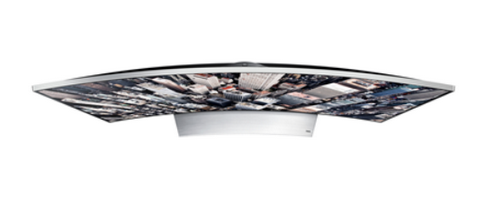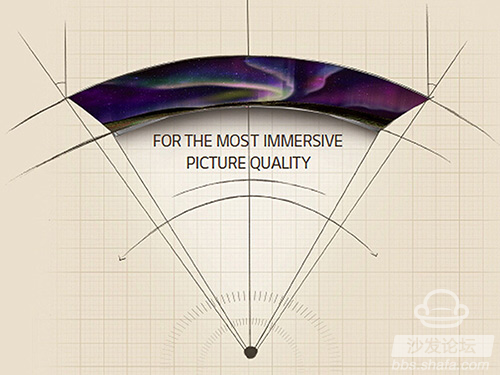As a new type of TV design, curved TV has become increasingly popular in recent years. Samsung and LG, especially Korean manufacturers, have spared no efforts in promoting curved TV. Although HDR has become a new trend at this year's CES Electronics Show, more and more manufacturers have adopted curved screens as their basic design. So, how should consumers choose between flat and curved designs? Take a look at the pros and cons analysis together.
 The advantages of curved TV
The advantages of curved TV
1. The surface screen is more immersed and more deeply conscious
The mainstream view is that the curved design of the curved screen will make the screen feel more “surrounded†by the user, improving the peripheral visual effects and achieving better immersion. At the same time, because the curved screen looks more like 3D, Samsung and other vendors also achieve contrast at different positions by increasing depth processing, making the picture depth even better.
2. More effective perspective
Logically speaking, the curved image edge should have reduced the viewing angle, but the LCD panel usually suffers from degradation of the edge image quality due to backlight design issues. The curved screen design can better adjust the backlight direction for better color and contrast. In addition, the curved screen is similar to the movie screen design, which means that the larger the TV screen, the more focused and comfortable viewing effect.
3. Contrast in surface TV is better
This is an interesting statement, explaining in principle that the focused light of the curved screen can be projected more directly into the eyes of the user, with a contrast improvement of 1.5 to 1.8 times that of the flat screen. From the actual test results, most curved TVs do have a better contrast effect.
4. Curved TV looks cool
There is no doubt that the surface design looks more cool than a normal flat-screen TV and has a unique aesthetic, which is why many users choose curved TVs. At the same time, more and more high-end televisions use surface design.

The lack of curved TV
Cannot be wall mounted
If you buy a curved TV, the first limitation you have to face is the inability to achieve wall hanging. You can only place it on the TV cabinet. This may be a big obstacle for some users.
2. Surface TV is not big enough
For a curved screen design, the larger the size, the more the user can feel the effect. However, most of the 55-inch curved TVs have limited results, and the market is still not much more than 65-inch curved TV, which is a problem that curved TV needs to solve.
3. Curved TVs are more expensive
Undoubtedly, as a new type of design, flat-panel TVs are more expensive than flat-panel TVs of the same size. Due to the panel cost issue, large-size curved TVs are more expensive and the average family may find it difficult to afford them. At the same time, curved TVs need larger sizes to achieve better results and are more difficult to control in price.

1. The surface screen is more immersed and more deeply conscious
The mainstream view is that the curved design of the curved screen will make the screen feel more “surrounded†by the user, improving the peripheral visual effects and achieving better immersion. At the same time, because the curved screen looks more like 3D, Samsung and other vendors also achieve contrast at different positions by increasing depth processing, making the picture depth even better.
2. More effective perspective
Logically speaking, the curved image edge should have reduced the viewing angle, but the LCD panel usually suffers from degradation of the edge image quality due to backlight design issues. The curved screen design can better adjust the backlight direction for better color and contrast. In addition, the curved screen is similar to the movie screen design, which means that the larger the TV screen, the more focused and comfortable viewing effect.
3. Contrast in surface TV is better
This is an interesting statement, explaining in principle that the focused light of the curved screen can be projected more directly into the eyes of the user, with a contrast improvement of 1.5 to 1.8 times that of the flat screen. From the actual test results, most curved TVs do have a better contrast effect.
4. Curved TV looks cool
There is no doubt that the surface design looks more cool than a normal flat-screen TV and has a unique aesthetic, which is why many users choose curved TVs. At the same time, more and more high-end televisions use surface design.

The lack of curved TV
Cannot be wall mounted
If you buy a curved TV, the first limitation you have to face is the inability to achieve wall hanging. You can only place it on the TV cabinet. This may be a big obstacle for some users.
2. Surface TV is not big enough
For a curved screen design, the larger the size, the more the user can feel the effect. However, most of the 55-inch curved TVs have limited results, and the market is still not much more than 65-inch curved TV, which is a problem that curved TV needs to solve.
3. Curved TVs are more expensive
Undoubtedly, as a new type of design, flat-panel TVs are more expensive than flat-panel TVs of the same size. Due to the panel cost issue, large-size curved TVs are more expensive and the average family may find it difficult to afford them. At the same time, curved TVs need larger sizes to achieve better results and are more difficult to control in price.